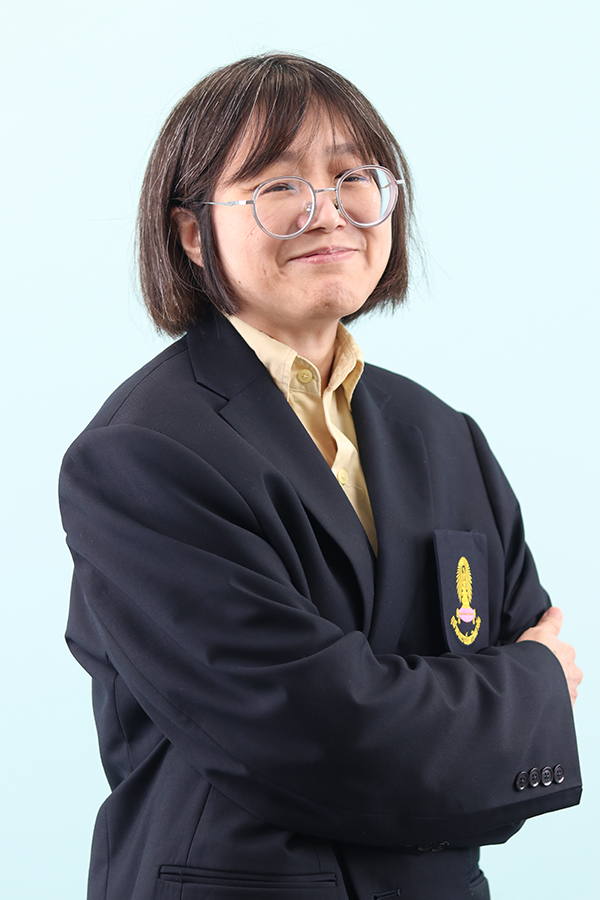
Associate Professor Supatana Auethavekiat, Ph.D.
รศ. ดร.สุพัฒนา เอื้อทวีเกียรติ
Education
- Ph.D. (Information & Communication Engineering), University of Tokyo, 2002
- M.Eng. (Information & Communication Engineering), University of Tokyo, 1999
- B.Eng. (Electrical Engineering), Chulalongkorn University, 1996
Email: Supatana.A@chula.ac.th
Research Interest
- Medical image processing and recognition
- image segmentation
- image classification
Research Cluster
Sa-Ing, V; Vorasayan, P; Suwanwela, N C; Auethavekiat, S; Chinrungrueng, C
Real-time 3D ultrasound denoising based on adaptive regularisation Savitzky-Golay filter Journal Article
In: Electronics Letters, vol. 53, no. 15, pp. 1029-1031, 2017, ISSN: 00135194, (cited By 0).
@article{SaIng2017,
title = {Real-time 3D ultrasound denoising based on adaptive regularisation Savitzky-Golay filter},
author = {V Sa-Ing and P Vorasayan and N C Suwanwela and S Auethavekiat and C Chinrungrueng},
url = {https://www.scopus.com/inward/record.uri?eid=2-s2.0-85025803903&doi=10.1049%2fel.2017.1669&partnerID=40&md5=e03cad59ba845e09fb26f0ae4a77932c},
doi = {10.1049/el.2017.1669},
issn = {00135194},
year = {2017},
date = {2017-01-01},
journal = {Electronics Letters},
volume = {53},
number = {15},
pages = {1029-1031},
publisher = {Institution of Engineering and Technology},
abstract = {The demand of the fast acquisition in 3D ultrasound (3D-US) imaging leads to the dense population of speckle noise which causes the difficulty in medical diagnosis. In this Letter, 3Dadaptive regularisation Savitzky-Golay (3D ARSG) filter is proposed as the real-time filter for removing speckle noise in 3D-US imaging. The 3D ARSG filter uses the local intensity homogeneity to classify between noisy and texture regions. The intensity in the noisy regions is heavily smoothed, while the resolvable edges remain sharp. The experiment on the denoising of the 3D simulated models and the 3D-US images indicated that 3D ARSG filter provided the image with far less noise and crisper objects' boundary than conventional methods. In addition, the proposed filter preserves the structural details with regard to the dimension and can denoise images in real time. © The Institution of Engineering and Technology 2017.},
note = {cited By 0},
keywords = {},
pubstate = {published},
tppubtype = {article}
}
Owasirikul, W; Tantivatana, J; Gansawat, D; Auethavekiat, S
Prediction of shape diameter undergoing coil embolization of saccular intracranial aneurysm treatment using a hybrid decision support system Journal Article
In: Australasian Physical and Engineering Sciences in Medicine, vol. 36, no. 2, pp. 177-191, 2013, ISSN: 01589938, (cited By 1).
@article{Owasirikul2013,
title = {Prediction of shape diameter undergoing coil embolization of saccular intracranial aneurysm treatment using a hybrid decision support system},
author = {W Owasirikul and J Tantivatana and D Gansawat and S Auethavekiat},
url = {https://www.scopus.com/inward/record.uri?eid=2-s2.0-84880133844&doi=10.1007%2fs13246-013-0193-1&partnerID=40&md5=008be971444d7a3d38fbbdb2141e9bc4},
doi = {10.1007/s13246-013-0193-1},
issn = {01589938},
year = {2013},
date = {2013-01-01},
journal = {Australasian Physical and Engineering Sciences in Medicine},
volume = {36},
number = {2},
pages = {177-191},
abstract = {The purpose of the study was to design a hybrid decision support system (HDSS) that could simulate the embolized coil selection pattern of the radiologists in aneurysms treatment. As the longest available length of the coils should be used in most cases, therefore only the shape diameter (SD) selection was modeled and varied. Ninety-eight aneurysms successfully treated by a radiologist with coil embolization were divided into two groups (86 for training and 12 randomly selected for validating). Eight aneurysms treated by another radiologist were also used to cross validate the proposed HDSS. The HDSS was developed using the classification and the linear regression methods (LRM). The dome and the width of an aneurysm were used as the system inputs. The system outputs were the SDs of the first three coils indexed according to the insertion order. The HDSS that consisted of Bagging classification and LRM achieved the highest accuracy for all cases. The errors were within 1 mm for the SD selection of the first two coils. For the third coil, the SD selection within 1 mm bound had 80 % accuracy. The experimental results indicated the feasibility of using the HDSS as the guidance for selecting the SDs of the first two coils. The selection of the third coil required more training data for the rarely used SD. Moreover, the cross validation with another radiologist showed the feasibility of using the proposed HDSS as the guidance, however further validation with more data is recommended. © 2013 Australasian College of Physical Scientists and Engineers in Medicine.},
note = {cited By 1},
keywords = {},
pubstate = {published},
tppubtype = {article}
}
Sermwuthisarn, P; Auethavekiat, S; Gansawat, D; Patanavijit, V
In: Eurasip Journal on Advances in Signal Processing, vol. 2012, no. 1, 2012, ISSN: 16876172, (cited By 6).
@article{Sermwuthisarn2012b,
title = {Robust reconstruction algorithm for compressed sensing in Gaussian noise environment using orthogonal matching pursuit with partially known support and random subsampling},
author = {P Sermwuthisarn and S Auethavekiat and D Gansawat and V Patanavijit},
url = {https://www.scopus.com/inward/record.uri?eid=2-s2.0-84872975809&doi=10.1186%2f1687-6180-2012-34&partnerID=40&md5=e22392b22afd901cf3a3a29c6ff94dff},
doi = {10.1186/1687-6180-2012-34},
issn = {16876172},
year = {2012},
date = {2012-01-01},
journal = {Eurasip Journal on Advances in Signal Processing},
volume = {2012},
number = {1},
abstract = {The compressed signal in compressed sensing (CS) may be corrupted by noise during transmission. The effect of Gaussian noise can be reduced by averaging, hence a robust reconstruction method using compressed signa ensemble from one compressed signal is proposed. The compressed signal is subsampled for L times to create the ensemble of L compressed signals. Orthogonal matching pursuit with partially known support (OMP-PKS) is applied to each signal in the ensemble to reconstruct L noisy outputs. The L noisy outputs are then averaged for denoising. The proposed method in this article is designed for CS reconstruction of image signal. The performance of our proposed method was compared with basis pursuit denoising, Lorentzian-based iterative hard thresholding, OMP-PKS and distributed compressed sensing using simultaneously orthogonal matching pursuit. The experimental results of 42 standard test images showed that our proposed method yielded higher peak signal-to-noise ratio at low measurement rate and better visual quality in all cases. © 2012 Sermwuthisarn et al.},
note = {cited By 6},
keywords = {},
pubstate = {published},
tppubtype = {article}
}
Sermwuthisarn, P; Gansawat, D; Patanavijit, V; Auethavekiat, S
Impulsive noise rejection method for compressed measurement signal in compressed sensing Journal Article
In: Eurasip Journal on Advances in Signal Processing, vol. 2012, no. 1, 2012, ISSN: 16876172, (cited By 9).
@article{Sermwuthisarn2012,
title = {Impulsive noise rejection method for compressed measurement signal in compressed sensing},
author = {P Sermwuthisarn and D Gansawat and V Patanavijit and S Auethavekiat},
url = {https://www.scopus.com/inward/record.uri?eid=2-s2.0-84872901874&doi=10.1186%2f1687-6180-2012-68&partnerID=40&md5=1c61ef76a8c045f615807a069bdb796c},
doi = {10.1186/1687-6180-2012-68},
issn = {16876172},
year = {2012},
date = {2012-01-01},
journal = {Eurasip Journal on Advances in Signal Processing},
volume = {2012},
number = {1},
abstract = {The Lorentzian norm of robust statistics is often applied in the reconstruction of the sparse signal from a compressed measurement signal in an impulsive noise environment. The optimization of the robust statistic function is iterative and usually requires complex parameter adjustments. In this article, the impulsive noise rejection for the compressed measurement signal with the design for image reconstruction is proposed. It is used as the preprocessing for any compressed sensing reconstruction given that the sparsified version of the signal is obtained by utilizing octave-tree discrete wavelet transform with db8 as the mother wavelet. The presence of impulsive noise is detected from the energy distribution of the reconstructed sparse signal. After the noise removal, the noise corrupted coefficients are estimated. The proposed method requires neither complex optimization nor complex parameter adjustments. The performance of the proposed method was evaluated on 60 images. The experimental results indicated that the proposed method effectively rejected the impulsive noise. Furthermore, at the same impulsive noise corruption level, the reconstruction with the proposed method as the preprocessing required much lower measurement rate than the model-based Lorentzian iterative hard thresholding. © 2012 Sermwuthisarn et al.},
note = {cited By 9},
keywords = {},
pubstate = {published},
tppubtype = {article}
}
Patanavijit, V; Auethavekiat, S; Jitapunkul, S
Video enhancement based on a robust hampel iterative SRR with a general observation model Journal Article
In: ECTI Transactions on Electrical Engineering, Electronics, and Communications, vol. 9, no. 2, pp. 223-235, 2011, ISSN: 16859545, (cited By 0).
@article{Patanavijit2011,
title = {Video enhancement based on a robust hampel iterative SRR with a general observation model},
author = {V Patanavijit and S Auethavekiat and S Jitapunkul},
url = {https://www.scopus.com/inward/record.uri?eid=2-s2.0-80055085162&partnerID=40&md5=d3a36f23da9daea9ed3d6ab19bd2fa66},
issn = {16859545},
year = {2011},
date = {2011-01-01},
journal = {ECTI Transactions on Electrical Engineering, Electronics, and Communications},
volume = {9},
number = {2},
pages = {223-235},
publisher = {ECTI Association},
abstract = {This paper proposes a novel robust SuperResolution Reconstruction (SRR) framework that can enhance a real complex video sequence and is applicable to any noise models. Although SRR algorithms have received considerable attention within the traditional research community, these algorithms are typically very sensitive to their assumed model of data and noise, which limits their utility. The real noise models that corrupt the measured sequence are unknown; consequently, SRR algorithms using L1 or L2 norm may degrade the image sequence rather than enhance it therefore the robust norm applicable to several noise and data models is desired in SRR algorithms. This paper proposes a SRR framework based on the stochastic regularization technique of Bayesian MAP estimation by minimizing a cost function. In order to tolerate to any noise models, the Hampel norm is used for measuring the difference between the projected estimate of the high-resolution image and each low resolution image, and removing outliers in the data. Tikhonov regularization is used to remove artifacts from the final result and improve the rate of convergence. Moreover, in order to cope with real video sequences and complex motion sequences, this paper proposes a SRR General Observation Model (GOM or affine block-based transform) devoted to the case of nonisometric inter-frame motion. In the experimental section, the proposed framework can enhance real complex motion sequences, such as Suzie and Foreman sequence, and confirm the effectiveness of our algorithm and demonstrate its superiority to other SRR algorithms based on L1 and L2 norm for several noise models (such as AWGN, Poisson noise, Salt & Pepper noise and Speckle noise) at several noise power.},
note = {cited By 0},
keywords = {},
pubstate = {published},
tppubtype = {article}
}

